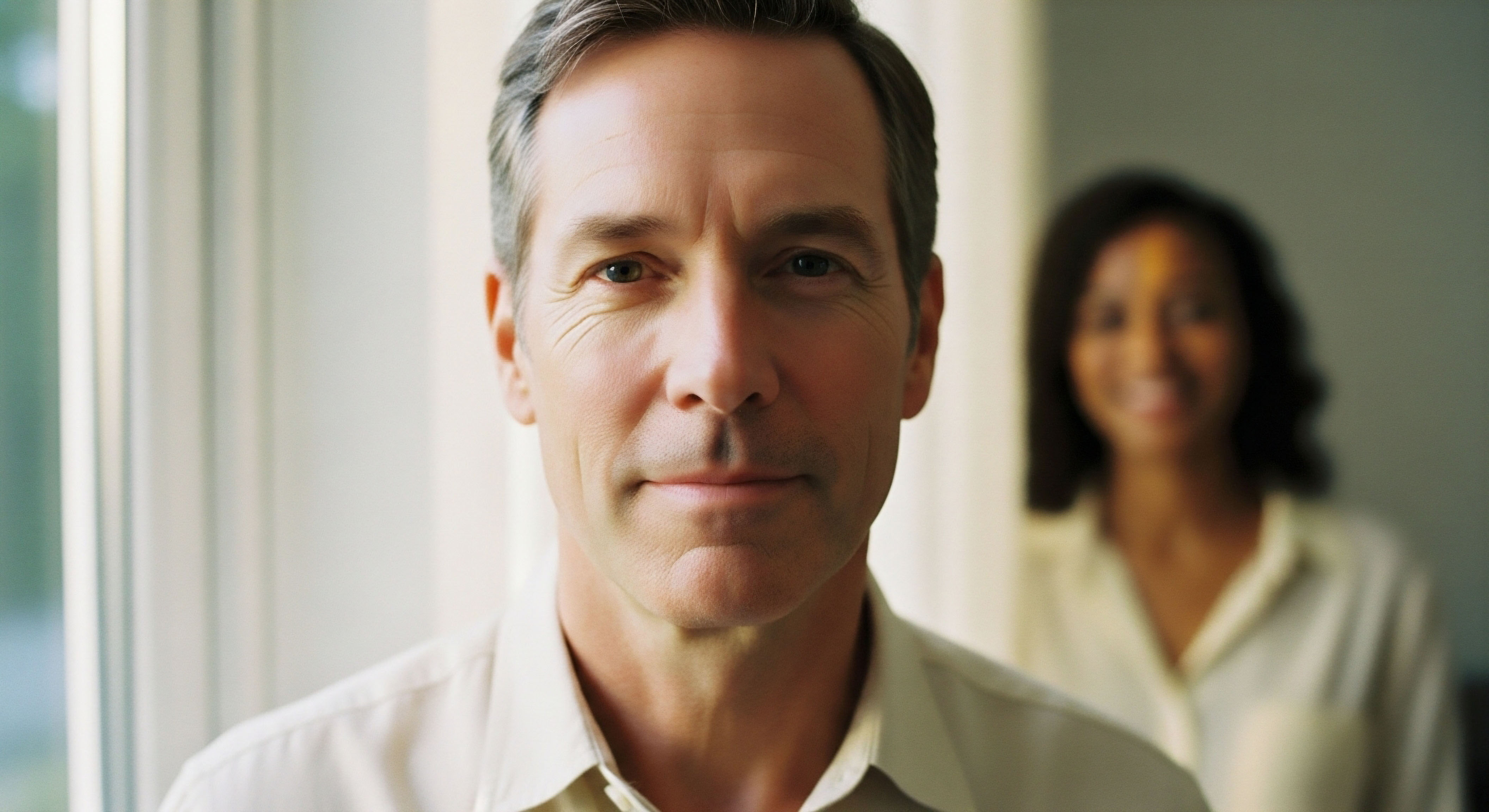

Fundamentals
You have started a journey toward biological optimization. Perhaps you are on a physician-guided protocol involving testosterone replacement therapy (TRT) or peptide therapy, and you feel a shift in your energy, your mental clarity, and your overall sense of vitality.
Yet, a pressing question remains, particularly on days when a workout is missed due to injury, illness, or the simple pressures of a demanding life ∞ are you undermining the cardiovascular benefits of this new biochemical state by being sedentary? This is a valid and intelligent concern. It stems from an intuitive understanding that the body is a deeply interconnected system, where one input invariably affects the outcome of another.
To begin answering this, we must first establish a core concept. Your cardiovascular system is not a static set of pipes. It is a dynamic, intelligent network that constantly responds to chemical and physical signals. Hormones, like testosterone, are powerful chemical messengers.
Physical activity, on the other hand, generates profound physical signals, such as changes in blood flow and pressure. Both are vital inputs, and they speak to your vascular system in distinct yet complementary languages. Hormonal optimization provides the raw materials and the chemical instructions for health, while exercise provides the physical stimulus that puts those instructions into practice in the most effective way.

The Role of Hormones in Vascular Health
When we discuss hormonal optimization, particularly with testosterone in men or balanced hormone protocols in women, we are talking about recalibrating the body’s master signaling system. Testosterone, for instance, has direct effects on the cardiovascular system. It interacts with the inner lining of your blood vessels, an active and critical tissue called the endothelium.
A healthy endothelium is flexible and produces a molecule called nitric oxide (NO), which allows blood vessels to relax and widen, promoting healthy blood flow and pressure. Properly managed testosterone therapy can support this process, contributing to endothelial health. It also influences body composition by increasing lean muscle mass and decreasing visceral fat, the metabolically active fat surrounding your organs that is a known driver of inflammation and cardiovascular risk.
Peptide therapies, such as those involving Sermorelin or CJC-1295/Ipamorelin, function differently but toward a similar goal of systemic wellness. These are not hormones themselves but secretagogues, meaning they signal your own pituitary gland to release more Growth Hormone (GH).
GH plays a role in maintaining a healthy body composition, supports cellular repair, and can have beneficial effects on lipid profiles and inflammation, all of which are foundational to cardiovascular resilience. Some research suggests Sermorelin supports heart function by helping regulate fat metabolism and reducing harmful inflammation.

The Indispensable Input of Exercise
Exercise communicates with your cardiovascular system through a completely different, yet equally important, channel. When you engage in physical activity, your heart pumps more blood, increasing the speed and force of flow against the endothelial lining. This physical force, known as laminar shear stress, is a powerful stimulus for the endothelium to produce more nitric oxide.
This is a direct, mechanical activation of the very same vasodilation pathway that hormones can influence chemically. You are, in effect, training your blood vessels to be more responsive and efficient.
Furthermore, contracting muscles release their own signaling molecules, known as myokines. These substances have widespread effects, including reducing inflammation, improving the way your body uses glucose, and communicating with other organs like the liver and fat tissue. This is a benefit that hormonal therapy alone cannot replicate. Exercise is a unique physiological event that puts the entire system through a positive stress test, forcing adaptation and building resilience in a way that a passive intervention cannot.
Optimizing hormones provides the blueprint for a healthier cardiovascular system, but exercise is the physical labor that builds the structure.
So, to address the core question directly at this stage ∞ hormonal optimization without exercise does not completely negate all cardiovascular benefits. Improving your hormonal environment is a significant step toward reducing risk. It can improve body composition, lower certain inflammatory markers, and support endothelial function.
However, the absence of exercise means you are missing a powerful, synergistic input. You are providing the chemical signals for health without the complementary physical signals that amplify and solidify those benefits. You are building a high-performance engine but never fully opening the throttle to see what it can do and to keep it running optimally.


Intermediate
Moving beyond foundational concepts requires us to examine the specific mechanisms through which hormonal protocols and physical activity exert their influence on cardiovascular health. The interaction is not a simple matter of addition; it is a complex synergy. When one component is absent, the system’s response is altered. Understanding this allows for a more sophisticated appreciation of why combining these two modalities is essential for achieving a state of profound wellness.
A properly managed hormonal optimization protocol, such as Testosterone Replacement Therapy (TRT) for men, is designed to do more than just elevate a single biomarker. For instance, a common protocol of Testosterone Cypionate is often paired with Anastrozole, an aromatase inhibitor, to manage the conversion of testosterone to estrogen, and Gonadorelin, to maintain the function of the Hypothalamic-Pituitary-Gonadal (HPG) axis.
This creates a carefully controlled hormonal milieu. The primary goal is to restore the systemic signaling that has been compromised by age or other factors, influencing everything from mood and cognition to metabolic function.

Hormones and Exercise a Tale of Two Signals
To truly grasp the dynamic, let’s compare the cardiovascular effects of hormonal optimization alone versus exercise alone. This reveals the distinct contributions of each and clarifies what is lost when one is omitted.
| Cardiovascular Marker | Hormonal Optimization (e.g. TRT) Alone | Exercise Alone | Synergistic Effect (Combined) |
|---|---|---|---|
| Endothelial Function (Nitric Oxide) |
May improve NO bioavailability through androgen receptor signaling in endothelial cells. |
Directly stimulates NO production via shear stress; increases eNOS enzyme expression. |
Maximal NO production and vascular responsiveness due to both chemical and mechanical stimuli. |
| Lipid Profile |
Can lower total cholesterol and LDL (“bad” cholesterol); effects on HDL (“good” cholesterol) are variable. |
Reliably increases HDL cholesterol; lowers triglycerides. |
Comprehensive improvement across the entire lipid panel, addressing multiple risk factors. |
| Inflammation (e.g. hs-CRP) |
Can reduce systemic inflammation by decreasing visceral adipose tissue. |
Acutely pro-inflammatory but chronically anti-inflammatory through the release of myokines like IL-6 from muscle. |
Powerful, dual-pronged reduction in chronic, low-grade inflammation. |
| Insulin Sensitivity |
Improves sensitivity indirectly by increasing muscle mass and reducing fat mass. |
Directly improves sensitivity by promoting GLUT4 transporter translocation to the muscle cell surface, independent of insulin. |
Optimal glucose disposal and metabolic flexibility, significantly reducing metabolic syndrome risk. |
| Arterial Stiffness |
Variable effects; some studies show modest improvements, others show none. |
Consistently shown to decrease arterial stiffness and improve vascular compliance. |
Enhanced arterial elasticity, reducing cardiac workload and improving blood pressure regulation. |
As the table illustrates, the two interventions are not redundant. Hormonal therapy provides a permissive environment for health, while exercise is the active process that capitalizes on that environment. For example, TRT can help build muscle mass. This is beneficial.
However, only the act of using that muscle in exercise triggers the cascade of myokine release and the direct improvement in glucose uptake that are so critical for metabolic health. Without exercise, the newly acquired muscle is less metabolically active, and a key benefit is left unrealized.

What Happens When Hormonal Signals Meet a Sedentary State?
When you introduce optimized hormone levels into a body that remains sedentary, you create a state of what could be termed ‘discordant signaling’. The body receives the chemical message to build and repair, but it does not receive the corresponding physical message that this new capacity is needed.
While there is evidence that TRT does not increase overall cardiovascular risk in hypogonadal men and may offer benefits, the context of these studies is crucial. The landmark TRAVERSE trial, for instance, found testosterone therapy to be non-inferior to placebo for major adverse cardiovascular events, which is reassuring. However, it also noted a higher incidence of atrial fibrillation and pulmonary embolism in the testosterone group, underscoring that hormonal changes have complex effects.
A sedentary body on hormonal therapy is like a high-performance vehicle that is constantly idling; the engine is running smoothly, but the full potential of the machine is not being expressed, and ancillary systems may not function as designed over the long term.
The critical element missing is adaptation to stress. Exercise is a form of hormesis ∞ a beneficial stressor. It challenges the heart to pump more efficiently, the blood vessels to dilate more effectively, and the mitochondria to produce energy more robustly. This repeated challenge is what builds a resilient and adaptable cardiovascular system. Hormonal optimization alone, while beneficial, does not provide this adaptive stimulus. It improves the baseline state but does not enhance the system’s capacity to respond to future challenges.

Can Peptide Therapy Bridge the Gap?
What about protocols involving peptides like Sermorelin or Ipamorelin/CJC-1295? These therapies stimulate the body’s own growth hormone production, which can lead to improved body composition, better sleep, and enhanced recovery ∞ all factors that indirectly support cardiovascular health. Research suggests GHRH agonists (the class of drugs Sermorelin belongs to) may reduce inflammation and improve cardiac remodeling after injury.
This is promising. However, like TRT, these peptides provide a chemical signal. They can help create a more favorable internal environment for cardiovascular health, but they cannot replicate the acute, mechanical, and systemic effects of physical activity. They are a powerful tool in the arsenal, yet they remain one half of a synergistic equation.


Academic
To fully dissect the query of whether hormonal optimization without exercise negates cardiovascular benefits, we must move beyond systemic effects and into the cellular and molecular arenas. The most precise examination of this question lies in what can be termed the Discordant Signaling Hypothesis.
This hypothesis posits that providing a potent anabolic and cell-signaling molecule like testosterone to a cardiovascular system that is not simultaneously receiving the mechanical signals of exercise may lead to suboptimal, or even maladaptive, cellular responses over time. The core of the issue is the interplay between chemical signaling via the Androgen Receptor (AR) and mechanical signaling via mechanotransduction in the vascular endothelium.

Molecular Cross-Talk at the Endothelial Level
The vascular endothelium is a critical interface, a monolayer of cells that actively participates in regulating vascular tone, inflammation, and coagulation. Both testosterone and exercise exert profound effects on this layer, but through distinct, albeit sometimes convergent, pathways.
- Testosterone’s Genomic and Non-Genomic Pathways ∞ Testosterone primarily signals through the intracellular Androgen Receptor. Upon binding, the testosterone-AR complex translocates to the nucleus and acts as a transcription factor, modulating the expression of various genes. In endothelial cells, this can lead to an upregulation of the gene for endothelial nitric oxide synthase (eNOS), the enzyme responsible for producing vasodilatory nitric oxide. Testosterone can also act via non-genomic pathways, rapidly stimulating eNOS activity through kinase cascades like the PI3K/Akt pathway, leading to acute vasodilation.
- Exercise and Mechanotransduction ∞ Physical activity increases cardiac output and blood flow, inducing fluid shear stress on the endothelial cell surface. This physical force is sensed by mechanoreceptors on the cell membrane (e.g. PECAM-1, integrins, ion channels). This initiates a signaling cascade that is a potent activator of eNOS, leading to its phosphorylation at Ser1177 and a rapid increase in NO production. Chronic exposure to this shear stress, as seen in regular exercise, also upregulates eNOS gene expression, creating a long-term adaptive increase in vasodilatory capacity.
The critical point is that while both stimuli can increase NO production, the context and accompanying signals are vastly different. Exercise-induced shear stress activates a broad suite of adaptive genes related to an antioxidant, anti-inflammatory, and anti-thrombotic cellular profile.
Hormonal stimulation of the AR in a static, low-shear-stress environment activates a different, perhaps narrower, set of genes. The question for long-term health is ∞ what is the net effect of chronic AR activation in the absence of the powerful, organizing signal of shear stress?

The Question of Vascular Remodeling
Vascular remodeling ∞ the structural change in blood vessels in response to long-term stimuli ∞ is where this discordant signaling may become most relevant. Exercise promotes beneficial, or ‘eugenic’, remodeling, leading to slight increases in arterial diameter and improved compliance. This is a well-orchestrated process.
What happens when the endothelium is chronically exposed to the growth-promoting signals of testosterone without the hemodynamic signals that should accompany increased metabolic demand? While current large-scale trials like TRAVERSE are reassuring regarding major adverse events in the medium term, they were not designed to assess the subtleties of long-term vascular morphology. The potential for suboptimal remodeling in a sedentary, hormonally optimized state remains an area requiring dedicated investigation.

Inflammation and Cellular Communication a Deeper Look
The inflammatory response further highlights the divergent effects. TRT can lower systemic inflammation, likely by reducing visceral adiposity. This is a clear benefit. Exercise, however, orchestrates a more complex and arguably more sophisticated anti-inflammatory effect. The acute stress of a workout causes muscles to release myokines, including Interleukin-6 (IL-6).
While often viewed as a pro-inflammatory cytokine, when released from muscle during exercise, IL-6 acts paradoxically, stimulating the release of potent anti-inflammatory cytokines like IL-10 and inhibiting the pro-inflammatory TNF-alpha. This is an active, dynamic process of inflammatory regulation.
Furthermore, exercise promotes the release of extracellular vesicles (EVs) from various cells, including muscle and endothelial cells. These EVs contain microRNAs and other signaling molecules that travel throughout the body, facilitating inter-tissue communication and promoting systemic adaptation. This is a highly evolved communication network that is uniquely activated by physical work.
Hormonal therapy does not trigger this specific, beneficial cascade of myokine and EV release. A person on TRT who is sedentary benefits from reduced fat-derived inflammation but misses out entirely on this muscle-derived, active anti-inflammatory signaling network.
| Molecular Process | Primary Mediator in Hormonal Optimization | Primary Mediator in Exercise | Potential Outcome of Discordant Signaling |
|---|---|---|---|
| eNOS Activation |
Androgen Receptor (AR) activation leading to PI3K/Akt signaling and eNOS gene transcription. |
Mechanical shear stress leading to phosphorylation of eNOS at Ser1177 and upregulation of eNOS gene expression. |
Sufficient basal NO production but lacking the enhanced responsiveness and adaptive capacity fostered by shear stress. |
| Anti-Inflammatory Signaling |
Indirect effect via reduction of pro-inflammatory adipokines from visceral fat. |
Direct effect via release of anti-inflammatory myokines (e.g. IL-6 leading to IL-10) from contracting muscle. |
A reduction in one source of inflammation (fat) without the gain of an active, regulatory anti-inflammatory system (muscle). |
| Cellular Energy Regulation |
Increased mitochondrial biogenesis secondary to increased lean mass. |
Direct activation of AMPK and PGC-1α pathways, driving mitochondrial biogenesis and metabolic efficiency. |
Increased mitochondrial number without the corresponding improvement in mitochondrial function and efficiency driven by metabolic demand. |
| Inter-Tissue Communication |
Endocrine signaling via circulating hormone levels. |
Paracrine and endocrine signaling via myokines and extracellular vesicles (EVs). |
A system that is chemically primed for activity but lacks the complex, real-time feedback loops initiated by physical exertion. |
In conclusion, from an academic, molecular perspective, hormonal optimization without exercise does not so much “negate” cardiovascular benefits as it creates an incomplete and potentially discordant physiological state. It provides a powerful anabolic and pro-survival signal without the corresponding functional, mechanical, and metabolic stimuli that have co-evolved to work in concert with it.
While this state is likely superior to a hormonally deficient state, it falls demonstrably short of the synergistic, robust cardiovascular health achieved when optimized biochemistry is paired with the indispensable stimulus of physical activity. The long-term consequences of this discordant signaling represent a frontier for clinical research in endocrinology and preventative cardiology.

References
- Kirby, Mike, et al. “Testosterone and the Heart.” European Cardiology Review, vol. 10, no. 1, 2015, p. 39.
- Sigalos, J. T. & Zito, P. M. “Sermorelin.” StatPearls, StatPearls Publishing, 2024.
- Lincoff, A. Michael, et al. “Cardiovascular Safety of Testosterone-Replacement Therapy.” New England Journal of Medicine, vol. 389, no. 2, 2023, pp. 107-117.
- Bagno, L. L. et al. “New therapeutic approach to heart failure due to myocardial infarction based on targeting growth hormone-releasing hormone receptor.” Oncotarget, vol. 7, no. 49, 2016, p. 80583.
- Vanhoutte, Paul M. et al. “The effect of physical exercise on endothelial function.” Pflügers Archiv-European Journal of Physiology, vol. 459, no. 5, 2010, pp. 769-782.
- Bhasin, Shalender, et al. “Testosterone Therapy in Men with Hypogonadism ∞ An Endocrine Society Clinical Practice Guideline.” The Journal of Clinical Endocrinology & Metabolism, vol. 103, no. 5, 2018, pp. 1715-1744.
- Pedersen, Bente K. and Mark A. Febbraio. “Muscles, exercise and obesity ∞ skeletal muscle as a secretory organ.” Nature Reviews Endocrinology, vol. 8, no. 8, 2012, pp. 457-465.
- Corona, Giovanni, et al. “Testosterone Replacement Therapy and Cardiovascular Risk ∞ A Review.” The World Journal of Men’s Health, vol. 35, no. 3, 2017, p. 136.
- Whirledge, S. & Cidlowski, J. A. “Glucocorticoids, stress, and fertility.” Minerva endocrinologica, vol. 35, no. 2, 2010, pp. 109-125.
- Fiuza-Luces, C. et al. “Exercise is the real polypill.” Physiology, vol. 28, no. 5, 2013, pp. 330-358.

Reflection
The journey into understanding your own biology is a profound one. The very question of how hormones and exercise interact reveals a sophisticated level of engagement with your own health, moving far beyond passive acceptance of symptoms. You have absorbed the foundational science, the clinical protocols, and the deep molecular mechanisms. Now, the path forward involves turning this knowledge inward.
Consider the state of your own system. Where are the points of synergy? Where might there be discordance? This clinical information is not a set of rigid rules but a map. It provides the terrain, highlights the landmarks, and suggests the most efficient routes.
Your unique life circumstances ∞ your genetics, your history, your daily demands ∞ determine your specific starting point on that map. The true purpose of this knowledge is to empower you to ask better questions, both of yourself and of the clinical professionals who guide you.
What does optimal function feel like for you? How does your body respond to the inputs you provide it? The data from lab work and the principles from scientific studies are invaluable, yet they find their ultimate meaning when synthesized with your own lived experience.
The goal is not to achieve a perfect score on a biological test but to build a resilient, adaptable system that allows you to function with vitality and purpose. This knowledge is your tool to begin that construction, to have a more collaborative partnership with your body, and to chart a course toward your own definition of sustained well-being.



